LONG MARCH (1934-1936)
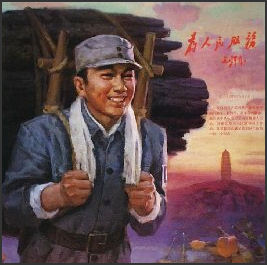 In 1927, after having formed an alliance with them, Chiang Kai-shek of the Chinese Nationalist Kuomintang turned on the Chinese Communist Party (CCP) and executed many of its leaders. The remnants fled into the mountains of Jianxi Province. In 1934, driven out of their mountain bases, the CCP's forces embarked on a “Long March” across some of China's most forbidding terrain to the northwestern province of Shaanxi, where they established a guerrilla base at Yan’an. Before and during the “Long March,” the communists reorganized under a new leader, Mao Zedong . [Source: Eleanor Stanford, Countries and Their Cultures, Gale Group Inc., 2001]
In 1927, after having formed an alliance with them, Chiang Kai-shek of the Chinese Nationalist Kuomintang turned on the Chinese Communist Party (CCP) and executed many of its leaders. The remnants fled into the mountains of Jianxi Province. In 1934, driven out of their mountain bases, the CCP's forces embarked on a “Long March” across some of China's most forbidding terrain to the northwestern province of Shaanxi, where they established a guerrilla base at Yan’an. Before and during the “Long March,” the communists reorganized under a new leader, Mao Zedong . [Source: Eleanor Stanford, Countries and Their Cultures, Gale Group Inc., 2001]
With the 1927 split between the Kuomintang and the Chinese Communist Party (CCP), the CCP began to engage in armed struggle against the Chiang regime. The Red Army was established in 1927, and after a series of uprisings and internal political struggles, the CCP announced the establishment in 1931 of the Chinese Soviet Republic under the chairmanship of Mao in Jiangxi Province in south-central China.
The Long March was a military retreat undertaken by the Red Army to avoid being captured by the Kuomintang's forces. In 1934, after suffering a string of defeats and a series of deadly annihilation campaigns by Chiang’s armies, the fledgling Communist Party and three Red Armies found themselves pinned down in the mountains of Jiangxi Province in southern China. After the Nationalist launched a powerful offensive, Mao made a decision for the Communists and Red Armies to break out of Jiangxi and flee their southern bases and retreat and meet up with Communist forces in Shaanxi, Gansu and Ningxia in northern China. This retreat became known as the Long March even though is was not one march, but several marches made up of different contingents of Communist armies on their way to the north. During the event Mao consolidated his hold over the CCP. In 1935 he became chairman, a position he held until his death in 1976.
With its military superiority, the The Kuomintang had the communists on the run. Along the way, the communists redistributed land from the rich owners to the peasants, many of whom joined their fight. The Nationalists controlled the cities, but the communists continued to grow in strength and numbers in the countryside. [Source: Eleanor Stanford, Countries and Their Cultures, Gale Group Inc., 2001]
The Long March is said to have lasted 368 days and covered 9,650 kilometers (about 6,000 miles). It began in Jiangxi on October 16, 1934 and crossed 24 rivers, 18 mountain ranges (5 covered with snow) and 11 provinces before it ended at the caves of Yenan (Yennan, Yanan) on the edge of the Gobi desert in northern China. During the march, 235 days were occupied by day marches and 18 by night marches. The army averaged a skirmish a day and spent 15 days in major battles. The highest trail reached an altitude of 4,300 meters.
Less than 30 percent of the 57,000 soldiers that took part in the march made to the final destination in Northwest China's Gansu province, according to Xinhua News Agency. Other source say that of f the nearly 80,000 marchers who started the journey only 6,000 made it to Yenan. Of the 200,000 participated in the march — with many joining the march after it began — 40,000 reached Yenan. Among the survivors were nearly all the high ranking Communist officials in Chinese government for the next 40 years — Mao Zedong, Zhou Enlai, Lin Biao and Deng Xiaoping. On their way north, the Communist redistributed land to the peasants, organized guerilla groups and armed the peasants with captured Kuomintang weapons.
Websites: Communist Party History Wikipedia article Wikipedia ; Illustrated History of Communist Party china.org.cn ; Everyday Life in Maoist China.org everydaylifeinmaoistchina.org; The Long March: Wikipedia article Wikipedia ; Paul Noll site paulnoll.com ; Chinese Government Account of Events chinadaily.com; Long March Remembered china.org.cn ; Long March map china.org.cn Mao Zedong Wikipedia article Wikipedia ; Mao Internet Library marx2mao.com ; Paul Noll Mao site paulnoll.com/China/Mao ; Mao Quotations art-bin.com; Marxist.org marxists.org ; New York Times topics.nytimes.com; Early 20th Century China : John Fairbank Memorial Chinese History Virtual Library cnd.org/fairbank offers links to sites related to modern Chinese history (Qing, Republic, PRC) and has good pictures
RELATED ARTICLES IN THIS WEBSITE: REPUBLICAN CHINA, MAO AND THE EARLY COMMUNIST PERIOD factsanddetails.com; JAPAN IN CHINA: WAR AND OCCUPATION BEFORE AND DURING WORLD WAR II factsanddetails.com; EARLY COMMUNISTS IN CHINA factsanddetails.com; EARLY CHINESE COMMUNIST IDEOLOGUES AND THEIR IDEAS AND GOALS factsanddetails.com; MAO ZEDONG, HIS EARLY LIFE AND RISE IN THE CHINESE COMMUNIST PARTY factsanddetails.com; MAO ZEDONG’S EARLY IDEAS ABOUT MAOISM AND REVOLUTION factsanddetails.com; MAO ZEDONG AND GUERILLA TACTICS factsanddetails.com; EDGAR SNOW'S ACCOUNT OF "THE LONG MARCH" factsanddetails.com; COMMUNISTS TAKE OVER CHINA factsanddetails.com; FAMOUS ESSAYS BY MAO ZEDONG AND OTHER CHINESE COMMUNISTS AS THEY TAKE POWER factsanddetails.com
RECOMMENDED BOOKS: "The Long March" by Edmund Jocelyn and Andree McEwen Amazon.com; "The Long March" by Sun Shuyun, based in accounts from 40 of 500 participants that were still alive in 2005 Amazon.com; "Red Star Over China" by Edgar Snow Amazon.com; “Mao Zedong: The Complete Works Volume 1" (Before 1934) Amazon.com; “Mao Zedong: The Complete Works Volume 2" (1934-1938) Amazon.com; "Mao; the Untold Story" by Jung Chang and Jon Halliday (Knopf. 2005) Amazon.com; "Mao's New World: Political Culture in the Early People's Republic" by Chang-tai Hung (Cornell University Press, 2011) Amazon.com; “From Rebel to Ruler: One Hundred Years of the Chinese Communist Party” by Tony Saich, Nigel Patterson, et al. Amazon.com; “The Birth of a Republic” by Hanchao Lu Amazon.com; “Republican China: Nationalism, War, and the Rise of Communism 1911-1949" by Franz Schurmann and Orville Schell Amazon.com; "The Generalissimo: Chiang Kai-Shek and the Struggle for Modern China" by Jay Taylor Amazon.com; The Cambridge History of China, Vol. 12: Republican China, 1912-1949, Part 1 by John K. Fairbank Amazon.com; The Cambridge History of China, Vol. 13: Republican China 1912-1949, Part 2 by John K. Fairbank and Albert Feuerwerker Amazon.com; . "Fanshen" by William Hinton is the classic account of rural revolution during the communist-led civil war in the late 1940s Amazon.com; “Penguin History of Modern China: 1850-2009” by Jonathan Fenby Amazon.com;; "China: A New History" by John K. Fairbank Amazon.com
Long March Mythology
According to Columbia University’s Asia for Educators: “All movements — political, religious, social — have their foundation myths and stories about their beginnings that reach heroic proportions over time and that are used to inspire and unify followers. For the Chinese Communist Party, it is the story of the Long March. In 1934, the Communists left their base in southeast China, where they had been more easily attacked by the Nationalists, and wound their way over 6,000 miles to the north on their Long March. The journey took two years. [Source: Asia for Educators, Columbia University, Primary Sources with DBQs, afe.easia.columbia.edu ]
"The Long March": A Poem by Mao Zedong”
The Red Army fears not the trials of the Long March
And thinks nothing of a thousand mountains and rivers.
The Wuling Ridges spread out like ripples;
The Wumeng Ranges roll like balls of clay.
“Warmly are the cliffs wrapped in clouds washed by the Gold Sand;
Chilly are the iron chains lying across the width of the Great Ferry.
A thousand acres of snow on the Min Mountain delight
My troops who have just left them behind.
[Mao Zedong, September 1935, from David L. Weitzman, “Mao Tse-tung and The Chinese Revolution”]
The Long March is portrayed as China’s version of Valley Forge, where a group endured extreme hardship and overcame impossible odds to succeed in a final victory and help found a nation. In reality it wasn’t a march , or even strategic retreat: the soldiers ran for their lives, trying just to stay alive, pursued not only by the Kuomintnag but also by the militias and armies of local landlords. Forced to evacuate their camps and homes, the participants were mostly Communist soldiers and government. There were only 35 women, the spouses of high leaders. During the Long March, Mao finally gained unchallenged command of the CCP, ousting his rivals and reasserting guerrilla strategy.
The Long March is recalled fondly with great idealism as a time when tens of thousands of Chinese peasant selflessly volunteered to join the fight. Hundreds of nationalist films and documentaries have been made about the event. It is difficult to determine fact from fiction. As of 2008 only about 500 Long March veterans remained alive. For generations they were considered heroes. Today some young Chinese regarded them as puppets of Communist propaganda.
Major Events and Myths of the Long March
The Long March began in October 1934, when the First Red Army set out from Yudu in Jiangxi province. They would eventually traverse some 12,500 km over 370 days and arrive in Wuqi, Shaanxi province on Oct 19, 1935. Pursued by the numerically superior Kuomintang army, the Long Marchers often had to cross difficult terrains, snowy mountains and swamps. Fatigue, hunger and sickness claimed many lives, and only one-tenth of the force that left Jiangxi completed the Long March.

Long March route Events and names familiar to Chinese include the Zunyi Conference, where Mao consolidated his leadership of the Red Army; Zhangjiajie, in Hunan province, the starting point of the Second Red Army's Long March; and Jiajin Mountain in Sichuan province, the first snow mountain on the route and the place where the First Red Army joined forces with the Fourth Red Army. The Red Army traversed the areas of many ethnic groups, including Miao, Dong, Qiang, Tibetan, Hui and Mongolian.
Arthur Waldron, a professor of history at the University of Pennsylvania wrote, “In the 1930s, the two sides came to blows, as Chiang launched a series of encirclement campaigns against the rural base areas where the Communists were steadily building a state-within-a-state. The last of these campaigns, in 1934, proved so successful that the Communists had to break through the Nationalist lines and flee to the Northwest.” [Source:Arthur Waldron, a professor of history at the University of Pennsylvania, China Brief (Jamestown Foundation), October 22, 2009]
The march began with a simple order to retreat from bloody battle in Fujian and move on as quicky as possible. Burdened by heavy equipment Mao’s forces moved slowly and were quickly caught by the Kuomintang. One survivor remembered the leaders telling the wounded, “If you can walk, then go. If you cannot, you will be left behind.” Medics remember leaving wounded behind because there were simply too many of them to carry.
The first major obstacle of the Long March occurred in the mountainous region of West Yunnan, where the Yangtze River passes through a series of gorges with thousand-foot-high cliff wall. The Nationalists thought they had the Red Army trapped when they secured all the ferries that crossed the river. According to Communist lore a Red Army commando force captured a Kuomintang group at a ferry crossing after marching 85 miles in 24 hours. Dressed in Kuomintang uniforms the commandos crossed the river and persuaded the nationalist troops on the other side to send of over the ferryboats. In the middle of the night the Red Army crossed the Yangtze, established a fort on the other side and secured their route to the north. [Source: People's Almanac]
Luding Bridge Over the Dadu River
The next major obstacle was the Tatu (Dadu) River in western Sichuan. Mao's plan was to beat the Nationalists to the river by tying them up in an area inhabited by the Lolo, a hill tribe notorious for its hatred of the Chinese. After convincing the Lolo that the Kuomintang were their bitter enemy, the Red Army took a short cut across Lolo land to the Tatu River. If the Lolo had not allowed them to this the Red Army would have been forced to march through Tibet. [Source: People's Almanac] The Red Army first tried to cross the flooding Dadu River at Anshunchnag but were unable to so and then trekked 130 kilometers over trackless Himalayan foot hills to Luding, a small settlement in a Himalayan valley not far form the Sichuan-Tibet border In May 1935 the Kuomintang troops arrived before the Communists at Luding Bridge, 120-meter chain link footbridge that spanned the Dadu River.
According to legend, by the time the Communists got to the bridge it had all of its planks removed and was guarded by a regiment of Kuomintang soldiers armed with machine guns. At night 22 brave Communist commandos, the story goes, went across the bridge — in some places hanging from the chains and pulling themselves forward hand over hand with grenades in their teeth — and captured the bridge, allowing the marchers to proceed. Mao later told Edgar Snow that the crossing the Dadu River was the single most important event of the Long March. Of the 80,000 soldiers that began the march in 1934, 20,000 made it as far as Luding Bridge.
Xu Fan wrote in the China Daily: “During the Long March, a pivotal battle was fought by the Red Army when 22 soldiers risked their lives to cross a 103-meter suspension bridge under fire from the Kuomintang forces. Reckoned as a military miracle, the conflict on Luding Bridge over the raging Dadu River in Southwest China's Sichuan province on May 29, 1935, has been recorded in the collective memory of Chinese people. Generations have read about this heroic episode in their school textbooks. A 2016 film called “The Warriors” highlighted the event. The two facts highlighted in the movie are: The Red Army troops wore sandals made of straw and covered some 120 kilometers on foot in two days to reach the bridge; and the 22 soldiers leading the charge climbed on the bridge from which many planks had been removed by the enemy and was held together only by 13 chains that were wildly swinging. [Source: Xu Fan, China Daily, October 20, 2016]
Red Army Soldiers on the Long March
Mao Guangrong joined the Red Army as a destitute 15-year-old orphan. During the battle to defend the Communist base at Yan'an, a bullet tore through Mao Guangrong's back and came out through his groin. It took five men to hold him down as they stuffed the wound with cloth to staunch the bleeding; the only treatment the troops could muster as they found against enemy forces. But nine months later, he was back in battle against Chiang Kai-shek's. Nationalists. It was simple; if the People's Liberation Army won the civil war, “we could have shelter and land. And we wouldn't suffer starvation. And we wouldn't be oppressed.” [Source: Tania Branigan, The Guardian, September 27, 2009]
Mao Guangrong, a soldier who joined the Red Army when he was a destitute 15-year-old orphan, told The Guardian.”Chairman Mao was a very simple person; he didn't wear smart clothes. He used old clothes we made ourselves and they had patches. After he finished his meals, he would walk out and talk to ordinary people... it wasn't like now, when it's so difficult to meet leaders.” [Source: Tania Branigan, The Guardian, September 27, 2009]
Mao Guangrong told The Guardian.”After one village had turned red, we would start the propaganda work about what should be done next; what kind of people should be killed; despotic gentry, [harsh] landlords and local tyrants.” Mao Guangrong recalled. “Also, beggars needed to be killed, because they didn't live on their own labor. “It was very easy to kill somebody. If you said anything reactionary they would kill you and if you didn't follow their leadership they killed you.” [Source: Tania Branigan, The Guardian, September 27, 2009]
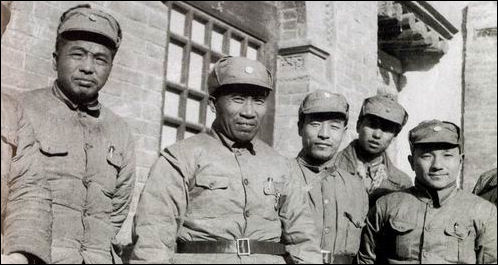
Deng Xiaoping and the Leaders of the 8 Route Army
Life on the Long March
The Communists are said to have traded opium for supplies and forced women to leave behind newborn children with peasant families out of concern that crying babies would endanger the troops.
While many officers rode on horses, soldiers walked. Many were proud of their uniforms and kept their spirits up singing songs with lines like “Play the violins!” Set up the revolutionary government!” Edmund Jocelyn, author of the 2006 book "The Long March", told the Los Angeles Times, the “marchers recall the Red Army as like joining a new family. They fell in love with the Chinese Party. That love carried them through the abusive relationship that was to come.”
When the marchers stopped Mao reportedly tended his vegetable garden along with other peasants.
A few women on the Long March were allowed to fight as guerrillas, but most did supply and support work. A young woman by the name of Kuo Chun-Ching disguised herself as a man and received the Red army's highest decoration after she was wounded in battle.
Suffering on the Long March
The soldiers were often hungry, on the verge of starving, some times eating grass and woody plants they could forage. In the winter they suffered in the cold. One Long March medic who talked to the Los Angeles Times recalled getting hit by a nighttime snowstorm before he and his comrades could build a fire or set up a ten, While the members of the climbed beneath a pile of canvas and huddle together, one young soldier insisted on keeping watch. By morning he had frozen to death.
At the Battle of Xing River, Mao’s division lost half of its numbers. Survivors remembered wading neck-deep in ice-old water and watching bodies of slain comrades float by as enemy planes dropped bombs on them. Many froze to death in their wet uniforms.
During the winter crossing of a mountain pass by one battalion, more than 300 soldiers became snow blind. Medics recall the difficulty in finding vegetables and herbs in the middle of winter needed to help them.
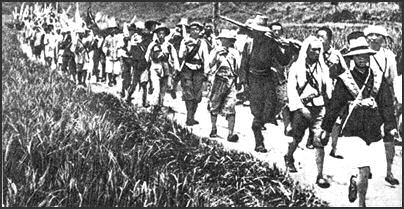
Hardships in Sichuan on the Long March
During the summer of 1935 the Long March passed though the Great Snowy Mountains of Sichuan where Mao wrote, "on Pao-tung Kand peak alone, one army lost two thirds of its transport animals. Hundreds fell down and never got up again."
Later, the Red Army was almost defeated when the Kuomintang advanced on them after factional fighting between Red Army forces led by Mao and forces commanded by Zhang Kua-tao, one of Mao's main rivals wihin the party. To escape the Red Army advanced through the mountains of western Sichuan where they were forced to steal from hostile native tribes to survive. "To get one sheep," Mao later wrote, "cost the life of one comrade." [Source: People's Almanac]
In September the Red Army passed through the steppes of central China where many perished from starvation and disease during a period of unusually strong rains. Describing this phase of the march, Zhou Enlai later wrote: "For us, the darkest time in history was during our Long March...especially when we crossed the Great Grasslands near Tibet. Our condition was desperate. We not only had nothing to eat, we had nothing to drink. Yet we survived and won victory."
People slept in shelters made from bushes tied together and subsisted on wild roots and herbs. Despite the heavy rains safe drinking was in short supply and some marchers were forced to drink their own urine. By the time the red Army arrived on the Kansu Plains there were only about 6,000 people left. [Source: People's Almanac]
End of the Long March
On October 25, 1935 the Long March ended when the southern Red Army joined the northern Red Army in Yenan in northern China. The participants in the Long March were not sure where and when their journey was to end. There were frequent debates as to what the final destination would be.
The end of the Long March was not some great “promised land” but rather was an impoverished corner of the Gobi desert that could barely support its own population let alone the Red Armies.
Soldiers didn’t have enough clothes to keep them warm. Women were ordered to return because there wasn’t enough food to feed them. Barely a month after the marchers were told their journey was over they were told to pack up and prepare to continue. The kidnaping of Chiang Kai -shek by one of his own generals is what saved them. One of the terms for his release was recognition of the Communists as legitimate, so a united Chinese force could devote its attention to the Japanese.
But even then the march wasn’t over for the 21,000 troops under the leadership of Kuo-tao, one of Mao’s main rivals. Their mission was to get help from the Soviets on their border with western China. But Mao purposely gave them contradictory orders, allowing them to be trapped by a Muslim warlord. Only 400 reached the border. The rest were killed or captured.
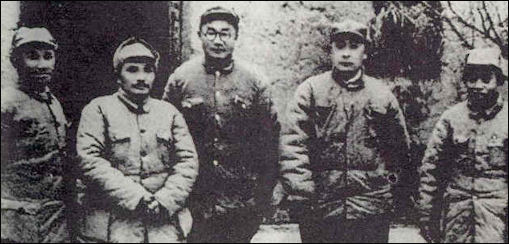
Deng Xiaoping Around the Time of the Long March
Truth Behind the Long March
It is hard to call the Long March a great victory, The Communist Army was largely on the run and when it fought a battle it was usually defeated, suffering huge losses. Many historians think the Chiang Kai-shek allowed the Communist to escape. Six weeks after the Long March began Mao’s army was reduced from 86,000 to 30,000 troops at the Battle on Xiang River. At most 15,000 died; the rest fled.
Many of the reported events of the Long Mrach, it seems, never happened or were exaggerated. The Luding Bridge incident appears to be a complete fabrication. There were no Nationalist troops at the bridge and there was no battle: only a skirmish with no casualties. The local warlord, who controlled the bridge and hated Chiang Kai-shek, let Mao's army pass and was later made a minister in the Communist government.
Many questions have been raised about the original story line. The distance covered now appeared to have been 6000 miles not 8000 miles and some question whether it lasted until 1936.
Mao's role in the Long March was often inaccurately reported. It has often beem claimed that he walked the entire 6,000 mile distance but in fact he was carried much of the way on a litter by porters and used the time to read. While Mao’s troops suffered huge losses, not a single senior party member was killed or even seriously wounded.
The Long March was third longer than was necessary as Mao dragged the Red Army in a huge loop so he could go near the Soviet border to receive arms because the Soviets said that whoever made first contact with them would be recognized as the leader of the Chinese Communist Party.
It also appears not all the participants of the Long March were enthusiastic volunteers. Some were press ganged captives. Sun Shuyun, author of a book on the Long March, interviewed one man who said he was barely into his teens when he was forced to join the Red Army and he only did so because his father was arrested and would not be released until the man agreed to join the army. The man thought of deserting but stayed on because he feared being caught and executed.
Driven by desperation and hunger, the armies took hostages for ransom. Purges continued until there were practicably no officers left to command battles
Legacy of the Long March
Even though the Red Army lost most its men during the Long March, the event was a turning point for the Communist Revolution. According to popular lore, the Communist forces and the People's Liberation Army (Red Army) were battered and worn but defiant. Self-sacrifice and compassion shown towards civilians made the Communists into heros. Over the next decade the Red Army regrouped, drew new recruits and wore down and ultimately defeated Chiang Ka-shek’s forces.
What motivated the marchers? A top general at the time later told Sun, “I had nor idea then and now. I doubt that even Mao knew what it was.” For the general, a survivor who rose up from extreme poverty, communism was a beautiful dream that gave him hope for a more just and advanced society.
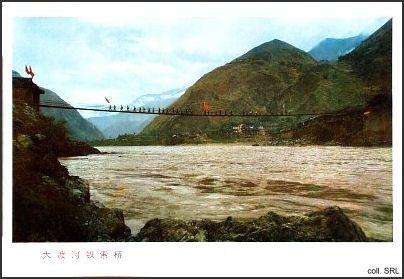
Luding Bridge
According to a poem by Mao Zedong:
"The Red Army, never fearing the challenging Long March,
Looked lightly on the many peaks and rivers,
Wu Meng's range rose, lowered, rippled,
And green-tiered were the rounded steps of Wu Meng
Warm-beating the Gold Sand River's
waves against the rocks,
And cold the iron chains of Tatu bridge,
A thousand joyous li of fresh snow on Min Shan
And then, the last pass vanquished, the Armies smiled."
The Long March has been preserved in exhibitions, ballets, books, a seven-part made-for-television movie, and even a Long March video game. The 60th anniversary of the event was commemorated with a television special featuring dancing soldiers with bayonets and a motorcade on a theater stage with an actor playing Deng Xiaoping waving through the sunroof. The Communist party reportedly has plans to build a Long March theme park in central Hunan province.
Communists in Yenan
As a final destination, Mao selected southern Shaanxi Province, where some 8,000 survivors of the original group from Jiangxi Province (joined by some 22,000 from other areas) arrived in October 1935. The Communists set up their headquarters at Yenan, where the movement would grow rapidly for the next ten years. Contributing to this growth would be a combination of internal and external circumstances, of which aggression by the Japanese was perhaps the most significant. Conflict with Japan, which would continue from the 1930s to the end of World War II, was the other force (besides the Communists themselves) that would undermine the Nationalist government. [Source: The Library of Congress]
At Yan'an and elsewhere in the "liberated areas," Mao was able to adapt Marxism-Leninism to Chinese conditions. He taught party cadres to lead the masses by living and working with them, eating their food, and thinking their thoughts. The Red Army fostered an image of conducting guerrilla warfare in defense of the people. Communist troops adapted to changing wartime conditions and became a seasoned fighting force. Mao also began preparing for the establishment of a new China. In 1940 he outlined the program of the Chinese Communists for an eventual seizure of power. His teachings became the central tenets of the CCP doctrine that came to be formalized as Mao Zedong Thought. With skillful organizational and propaganda work, the Communists increased party membership from 100,000 in 1937 to 1.2 million by 1945.
Mao Flirts and Waits After the Long March
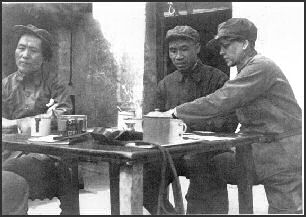
Mao in Yenan in 1937
The Mao set up a military command post in Yenan and directed the Communist army for the 13 years from there. Young people from all over China came to Yenan to join the revolution or simply catch a glimpse of history. Mao spent his time in Yenan reading and relaxing, discussing poetry and plans of equality between the sexes with attractive women, and encouraging revolutionaries such as Zhu De and Zhou Enlai to take up ballroom dancing. In Yenan Mao developed the Yenan Rectification campaign, aimed at purifying beliefs of new recruits to the Communist Party and ensuring their loyalty and fealty to Mao as the ultimate authority. The campaign was a precursor to grander and more destructive purges that occurred when the Communists took power.
According the book "Mao's Brothers and Sisters"," Mao's second wife He Zichen became enraged with her husband's flirtation with an American journalist named Agnes Smedly and her beautiful Chinese translator Lily Wu. According to the book the two women "became the target of all the female comrades."
One night He reportedly burst in on Mao and Wu while they were talking about poetry and called Mao a "rotten egg" who "wants to usurp me with capitalist dances." She pulled Wu's hair "until her head started bleeding" and got into a fight with Smedly after calling her an "imperialist" who was "to blame for everything." Smedly reportedly said He was "weak and monastic, an unsuitable companion for a revolutionary leader."
Mao fine tuned many methods of political terror — purging real and imagined enemies — that would serve him well when he was leader of China. He also sold opium to raise money for his army.
Long March Tourism
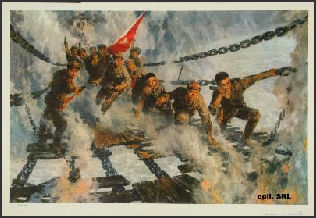
Long March Luding Bridge
propaganda poster Mu Qian wrote in the China Daily, “When the Red Army trekked through some of China's most remote and treacherous areas during their Long March, they could never have imagined the same route would become part of the travel itinerary for travelers 70 years later. Today, many places along the Long March have become tourist destinations as China tries to boost "red tourism". The National Tourism Administration recently selected the "Long March Route" as one of 12 national tourism routes. [Source: Mu Qian, China Daily, June 9, 2011]
On the website of China Travel Service, "red tours" rank at the top of themed tours, above "folklore tours" and "international horticultural exposition tours". The itineraries offered by the company cover many areas of the Long March - from Jiangxi province, its starting point, through Guizhou, Yunnan and Sichuan, to Shaanxi, where the Red Army ended its journey. China CYTS Tours launched its "Year of Red Tourism" in 2011 with the theme, "Retracing the Long March". Its first group of tourists went to Guizhou's Long March sites such as Loushanguan, Chishui and Maotai.
"With an increase in living standards, people are looking for a more spiritual travel experience," says Ge Qun, vice-president of China CYTS Tours. "The reason 'red tourism' has become more popular is that Chinese people want to know more about history." Equipped with better infrastructure, many of these areas are more accessible today, and their natural beauty is attracting some travelers.
Places where important events during the Long March happened are now hot destinations on "red tours", such as the former site of the Zunyi Conference which consolidated Mao Zedong's leadership of the Red Army, and Luding Bridge where the Red Army crossed the Dadu River in 1935. On the Long March, the Red Army traversed the areas of many ethnic groups, including Miao, Dong, Qiang, Tibetan, Hui and Mongolian. Their diverse cultures are also one of the attractions of tour itineraries related to the Long March.
Zhangjiajie, in Hunan province, was the starting point of the Second Red Army's Long March. With its breathtaking rock formations, the area is one of the most popular tourist sites in China and was the setting for many scenes in the blockbuster Avatar. Jiajin Mountain in Sichuan province, the first snow mountain on the route of the Long March and the place where the First Red Army joined forces with the Fourth Red Army, is now a national forest park known for its rich botanical and zoological resources.
Red Rock Treks is a company set up by Englishman Ed Jocelyn, who retraced the entire marches of the First and Second Red Army on foot, in 2002-03 and 2005-06, and who co-authored the book The Long March, which was published in five languages in 2006-07.
Detailing the itinerary he designs for foreign travelers interested in the Long March, Jocelyn says: "From a Tibetan village in the valley of the Blackwater River, we will first cross two of the great snow mountains of western Sichuan province. At 4,450 meters, the pass over the second of these is the highest point of Mao's entire march. ..We then enter the infamous grasslands, a vast region of prairies, swamps and bogs more than 3,400 meters above sea level on the Qinghai-Tibet Plateau, where hundreds of Mao's soldiers perished in 1935.
"Finally, we explore the ancient and long-disused trail into Northwest China via the stunning valleys of Lawa and Baozuo. Accompanied by a Tibetan horse team, we will trek and live alongside yak herders whose way of life has changed little for hundreds of years...This is a true exploration not just of history, but also of a country and culture rarely seen by outsiders."
Image Sources: Ohio State University, Agnes Smedley and Landsberger Posters http://www.iisg.nl/~landsberger/
Text Sources: New York Times, Washington Post, Los Angeles Times, Times of London, National Geographic, The New Yorker, Time, Newsweek, Reuters, AP, Lonely Planet Guides, Compton’s Encyclopedia and various books and other publications.
Last updated August 2021
